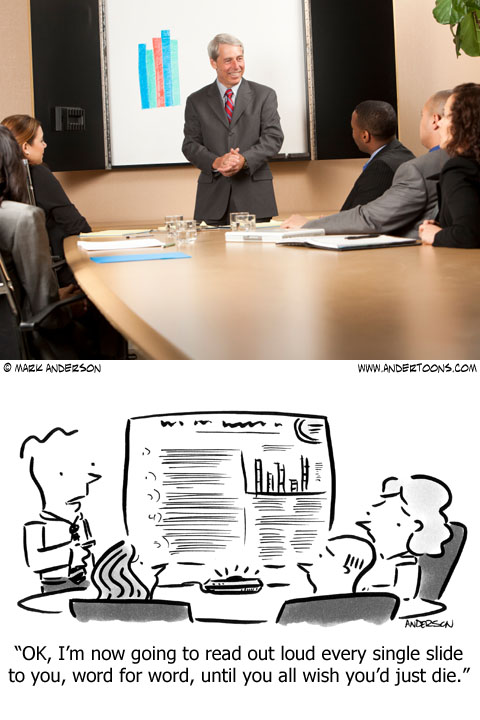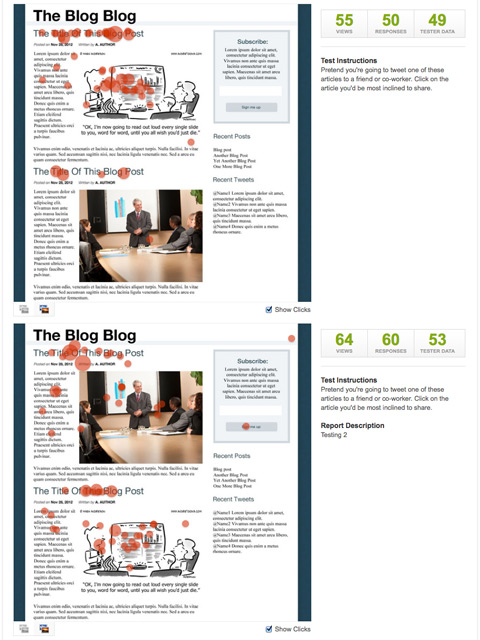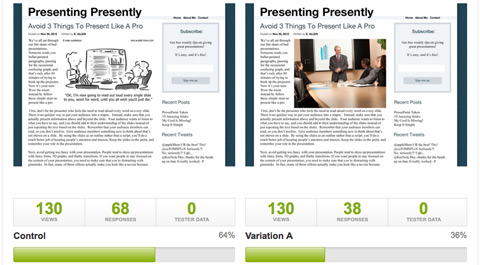After testing over 300 participants, I believe I’ve demonstrated that cartoons are more than simple entertainment, they are potentially powerful social media tools when used correctly.
Why Do We Use Images?
To begin with, images are aesthetically pleasing. Great masses of text are fine, but a reader’s eye needs a place to rest. Images also help introduce, reinforce and clarify ideas. And if you’re concerned with SEO, image tags offer additional clues about your content. So while you shouldn’t judge a book by its cover, you don’t often see an unattractive cover on a bestseller.
Good visuals are important, and there’s no shortage of graphs, stock photos, and infographics to use. But I’d like to suggest an often forgotten or ignored visual to add to your repertoire, cartoons.
Cartoons are written off, I believe, because they’re funny. You’re trying to make a point, add to a discussion, or sell a product, and you’d like to be taken seriously. But you also want your efforts to be seen and, more importantly, shared. And cartoons have an inherent shareability that should not be taken lightly.
But while there exists much research and advice on why and how to use all kinds of other images, most of what you read about using cartoons falls under “people just like cartoons.” That is why I’ve attempted to measure the effect of cartoons on the sharing of associated content.
Cartoon vs. Stock Photo
Three tests were conducted comparing this stock photo, and this cartoon:

The photo was purchased at iStockphoto.com. The color photo was resized and slightly cropped to 480 x 360 pixels. iStockphoto shows an initial upload of the photo on 6/17/11. It has sold more than 100 times.
The cartoon is from Andertoons.com. The grayscale image is 480 x 360 pixels. It was created on 6/22/10 and as of this writing has sold 51 times.
Each test showed participants the images and asked one question:
“Pretend you’re going to tweet one of these articles to a friend or co-worker. Which article would you be most inclined to share?”
I chose Verifyapp.com to administer the test, and Enrollapp.com to provide anonymous paid participants. There were no indications provided as to the identity or purpose of the tester. And while participants could be categorized as Internet savvy (being early adopters of Enroll), I believe they are also representative of the kind of person who would be an active and enthusiastic sharer of online content.
Test 1 – Photo & Cartoon Presented Together
The first test presented a generic blog page with dummy content. There were 110 total participants. 50 saw the cartoon image on top and the photo below, 60 saw the images’ placements reversed:

Tracking their clicks, those seeing the cartoon on top chose the content with cartoon an impressive 90% of the time. More interesting, however, is that when the images were reversed, those respondents still chose the content with cartoon over the photo 57% of the time, even though the cartoon was grayscale and further down the page:

Test 2 – Photo & Cartoon Presented Individually
The second test presented two similarly generic blog pages with dummy headlines and text. Each page was identical except for the inclusion of the photo or cartoon. There were 105 total participants.
Two A/B tests were created, one with the cartoon as the control and the photo as the variation, and another test with these positions reversed. Because I later discovered that the positions of the control and variation are presented randomly by Verify, I think it’s reasonable to present the data from both A/B tests combined.
Combining the two tests, 75% indicated that they would prefer to share the content with cartoon vs. the content with photo:

This test also allowed participants to enter comments afterward:
“Somehow the cartoon (vs. the photo) makes it more informal, which I associate with Twitter.”
“The cartoon adds value to the text content, where as the stock photo is basically just decoration.”
“It has the cartoon and the caption underneath and it was funny. It made me more interested in reading the rest of it.”
“The humour (of the illustration) is something that reflects my personality so I’d be happy to share it. The stock photography version is trite.”
Some respondents did of course choose the photo, most often citing color as a key factor.
One participant did make an unexpected and excellent point:
“…I think this test is flawed, because the test is about visual content and not actual textual content, and I’d only really share a URL based on the substance of its message, not its accompanying imagery.”
Although my initial idea was to nullify surrounding content to more accurately gauge image effectiveness, I wanted also to be as accurate as possible. So I administered one additional test:
Test 3 – Photo & Cartoon Presented Individually (Actual Text)
This iteration repeated the conditions of Test 2 with one important exception: I replaced the dummy content with actual readable content about presenting effectively.
With 106 participants, readable text, and positions of the control and variation images again randomized, I was impressed that 64% again said they would prefer to share the article containing the cartoon:

Comments after the test included:
“I like the stock cartoon a lot more than the generic stock photo.”
“I think the cartoon graphic is interesting, it adds more value to the theme of the article. Which relays more information to the user.”
“I prefer the cartoon. It has a more personal relation with the article than an overused stock photo.”
“The image seems more engaging that a stock photo that we’ve probably seen many times already.”
Cartoons Are Underused And Undervalued
While I do not wish to present cartoons as a sort of social media panacea, after three quite different test iterations and over 300 participants, I believe the results speak for themselves. The cartoon competed extremely well for attention, and was seen as more interesting, engaging, and shareable than a traditional color photo. The demonstrated social benefit of complementing content with a relevant cartoon is clear and compelling, and savvy marketers can be advised to add cartoons to their marketing repertoire.
